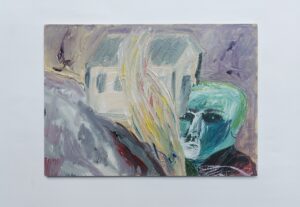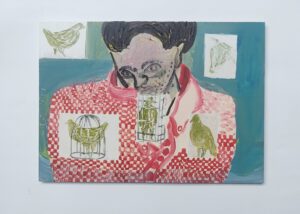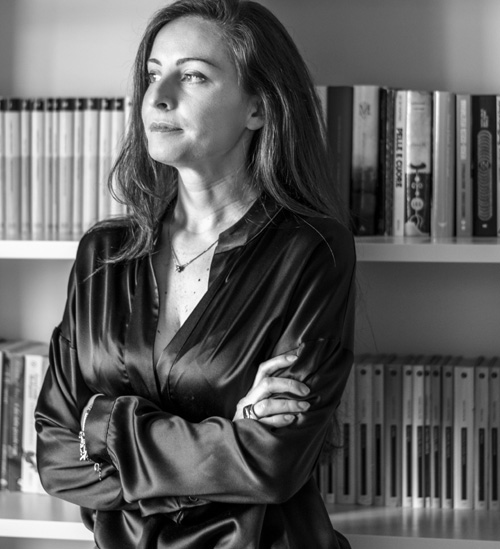What has recently characterized the city of Rome has been the prevalent diffusion of artist studios, which has given visibility to their protagonists, allowing them to acquire certainty and fortitude in their practice. Yet, upon extensive reconnaissance from the capital, it is useful to reflect what the developments and transitions following this phase were, which according to the most benevolent interpretation was a gigantic athletic test of artists and collective critical intellect. Even more, one must possess a stone heart not to feel the need to ask oneself whether a dazzling, stupendous and impossible new painting really matured after that period simultaneously.

David Noro, Seasons, acrylic, phototransfer, lacquer, ink on wood, 40 x 30 cm, 2023, courtesy the artist
At the same time, one must not underestimate a fundamental aspect: Rome has always been a favorite destination for connoisseurs who impatiently abandoned their roots to get to know an articulate land, driven «by the love for its wrinkled and polychrome mask, perhaps stucco and perhaps flesh».[1] Thus, for the announced reconnaissance, it is useful to turn our gaze to other cultural realities, such as the foreign Art Academies, aggregation points that breathe different and vital instructive motivations. Here it is, in this regard, that the Denmark Academy in Rome cyclically organizes month-long residencies for the benefit of devotees of various subjects who intend to develop a project that finds basis and aspiration for the Italian territory. Among the current attendees there is the artist David Noro (1993, Copenhagen), who occupies the painting workshop from September 4 to 29 of 2023, with a studio entirely dedicated to his own grandfather, originally from Piglio (Frosinone), who holds firm to the tradition of making “basto”, wooden saddles stuffed with fabric for donkeys. So Noro moves with an almost sorcerous ability, playing on the generational theme, building a quest of stubborn and affectionate curiosity toward his origins. Hence, everything the artist creates in residence is generated by a graceful breath, kept alive by the study of the original process of craft making, which allows him to handle different textures unexpectedly. In such a context, Noro discovers a drapery of language [2] that accompanies him in the discovery of a new environment of language, also dilating the attention on the heads of human expression, always fixed in their most absurd expressive accident.

David Noro, How to belong, 2023, 25 x 35 cm, acrylic, lacquer, ink on wood, courtesy the artist
However, to understand Noro’s research, it is useless to make media distinctions, since the paintings on fabric and board conceived in residence present the same creative principle: colors arranged like eye spots, reciting scratching sounds, yet tending to hermetically close in their distorted and barely mellowed poetry. On the other hand, there are different ways of approaching such a personal quest and, for the occasion, the artist develops in a personal and suggestive way with a reflective gestation that induces him to mull over the impulses, to mature, in contrast, a pictorial act, svelte, lax and vivid with acerbic fascination. Thus, for the artist it is quite evident, and therefore palpable, that the cultural womb of his family of origin urges him to reflect on himself as well, and sometimes it happens that his face appears in deliciously exasperating scenes veiled by a dry hilarity. Some studies see him hovering like a free butterfly, allowing him to paint without any easel for support, but rather on horizontal tables with the use of classic painting tools, along with rollers and machinery of printmaking practice.

David Noro, Chi sa decifrare il canto degli uccelli, 2023, 25 x 35 cm, lacquer and acrylic on wood, courtesy the artist
This fantastic intent on the extreme experimentation generates a painting of touch that is not visually and deliberately sublime, but confident and impactful, reasoning that the figures unfold without any perspective just as in a frieze, and unwittingly acquire an aura of ancient primitivism, such that by isolating, the subject is effectively increased in its content. Thus, if the motifs stand out on the flat surface, it is because they are the result of a strobing imagination, just as in a fictitious and flat map in which there is to be inferred a tale, reflection or artifice. Moreover, a place is barely hinted at, but where it is located is not given, so that the elements transcribed in full stand as psychic eddies in which spontaneous facial grimaces make us reflect on the process of recognition, understood as a minimal gap between the time it takes us to recognize our own image and the image of others.

David Noro, Inbetween, 2023, 25 x 35 cm, acrylic on wood, courtesy the artist
Of further interest is the disruption of the work’s structure, and in fact perspective is rare and the relationship between the background and what is there in the foreground activates the dynamism of a dream, sometimes calm and without orgasm, while in other cases impetuous, as aimed at contrasting the exigent data with quick pictorial notations that continue like a jolt at the edge of the support. In other works, however, a light spirit of calculated humor hovers, with a preponderant physiognomy, which now stands not as his own portrait or that of others, but as a plastic face, which knows redness, and in which the eyes and nasal forms end up being the most interesting parts. This effluvium of antiquity, at times cave-like and grotesque, leads us to question whether the face depicted hanging in the void of the sky of watery uncertainty is a living thing, or is it perhaps of color or perhaps of flesh?

David Noro, Night in Rome, acrylic, lacquer, ink on wood, 2023, 25 x 35 cm, courtesy the artist
Here, at present it is this reflection that imbues Noro and of which one will see, one is sure, more and more interesting developments, and which nevertheless induces another question to arise: can we be reflected in a grimace, will it be a melancholy resemblance to ourselves, an unraveling of our appearance or a caricature inflection that we acquire when we brush aside the benefit of the doubt? No, it would be reductive to prefer such a choice, and so Noro’s masks rather hint at a place where thoughts are laid, as opposed to the deliberate silence in the luxurious intellectual Roman world, where so many stucco masks thrive. And then it will indeed be fruitful to discover new and noisier places where jovial intellectual and thoughtful brawls are given substance, theaters of dialectics where characters wearing masks made perhaps of color or perhaps of flesh are favored.
Maria Vittoria Pinotti
[1] Giorgio Manganelli, La maschera italiana, in Lunario dell’orfano sannita, Piccola Biblioteca Adelphi, (1991), 2018, p. 33
[2] Georges Didi-Huberman, Ninfa profunda. Saggio sul panneggio-tormenta, Abscondita, Aesthetica, (2017), 2022, p. 50
Info:
David Noro
Accademia di Danimarca a Roma
Via Omero, 18, 00197, Roma
4/9/2023 – 29/9/2023
Sito web: https://www.acdan.it/

Maria Vittoria Pinotti (1986, San Benedetto del Tronto) is an art historian, author, and independent critic. She currently is the coordinator of Claudio Abate’s photographic archive and Manager at Elena Bellantoni’s Studio. From 2016 to 2023 she was the Gallery Manager in a gallery in the historic center of Rome. She has worked with ministerial offices such as the General Secretariat of the Ministry of Culture and the Central State Archive. Currently, she collaborates with cultural sector magazines, focusing on in-depth thematic studies dedicated to modern and contemporary art.






NO COMMENT